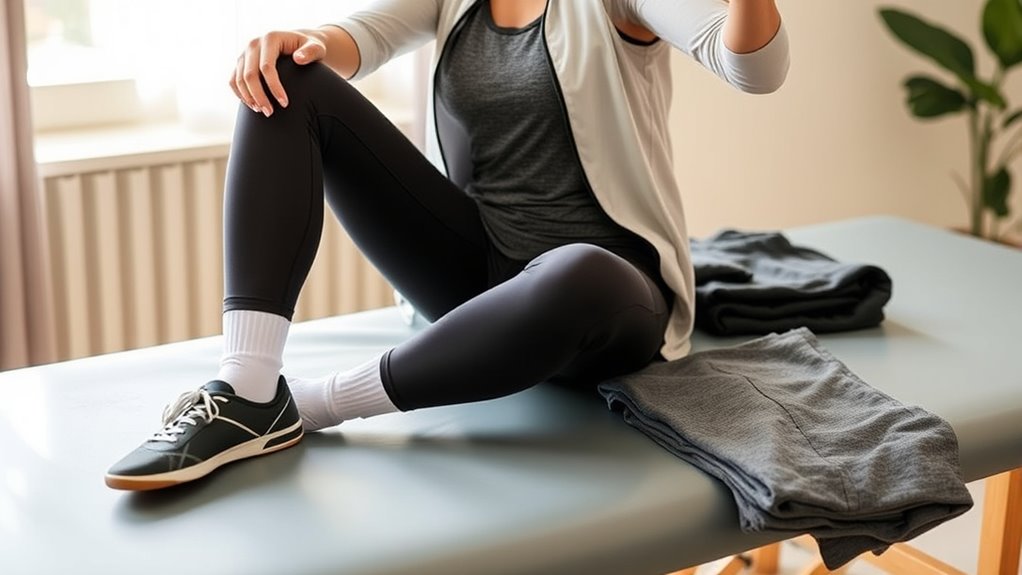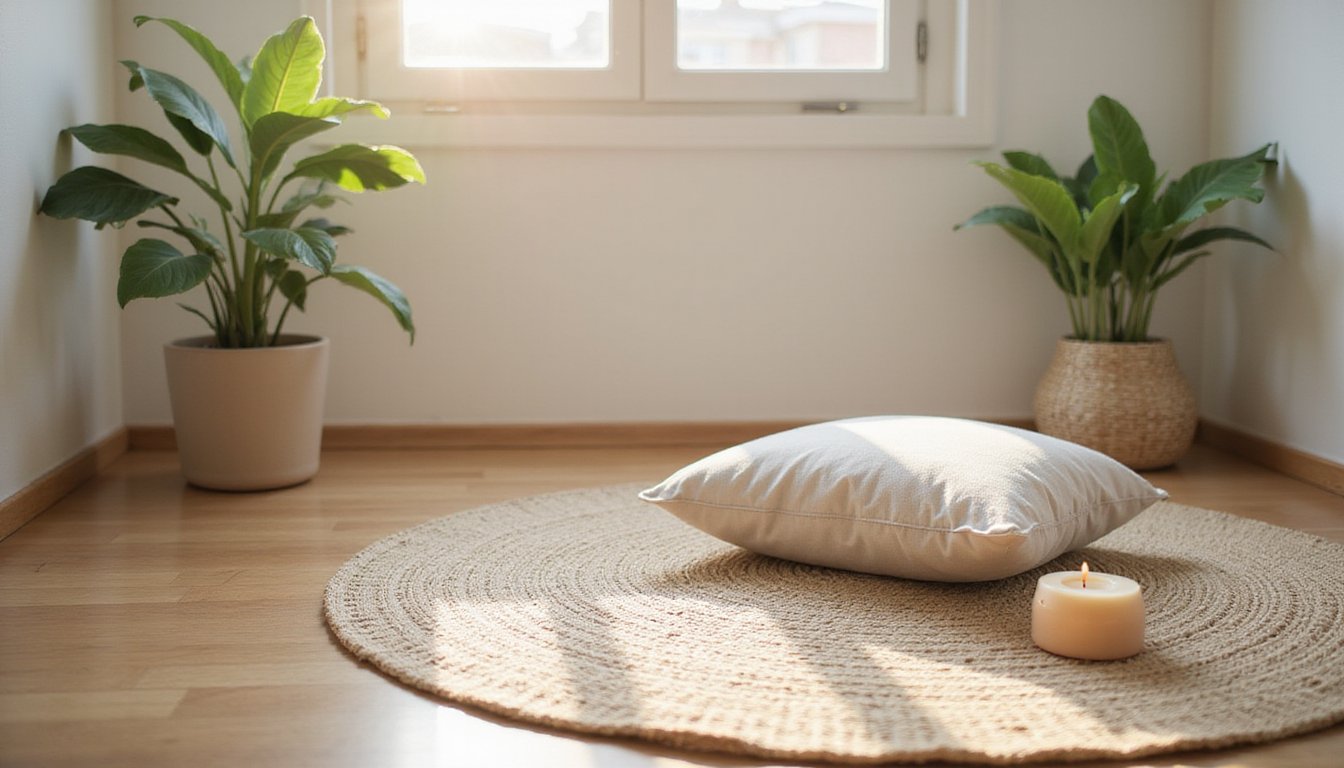For your physical therapy appointment, wear loose-fitting athletic clothes like t-shirts, tank tops, shorts, or sweatpants that allow easy movement and therapist access to treatment areas. Choose moisture-wicking fabrics and supportive athletic shoes with good traction. Avoid restrictive clothing like jeans, dress clothes, or high heels. Remove dangling jewelry that might interfere with treatment. These clothing choices will enhance your comfort and help your therapist properly assess and treat your condition.
The Importance of Proper Attire in Physical Therapy

When attending physical therapy sessions, what you wear greatly impacts your treatment outcomes. Proper attire significance extends beyond mere comfort it directly affects your therapist’s ability to access and treat injured areas effectively. Wearing loose athletic pants or shorts allows for unobstructed examination of knees, hips, and ankles, while supportive athletic shoes provide the stability needed for safe movement. An example highlighting this reality is Terry’s case, where her snug leggings restricted proper examination of her knee injury. Physical therapists recommend that patients choose moisture-wicking fabric for their sessions due to potential sweating during exercises. Patients are encouraged to avoid excessive jewelry as dangling accessories interfere with exercise movements and assessment procedures.
Your comfort impact is similarly essential. Moisture-wicking fabrics keep you dry during exercises, while elastic waistbands prevent restriction during movement. Tight clothing like jeans or restrictive leggings can limit your range of motion and impede progress. By choosing appropriate, functional clothing, you’re not just following guidelines you’re actively participating in optimizing your therapy results and recovery timeline.
Upper Body Clothing Recommendations
Selecting appropriate upper body attire for physical therapy sessions greatly impacts both comfort and treatment effectiveness. Opt for loose t-shirts or tank tops that allow unrestricted movement and give your therapist easy access to shoulders and neck. Short sleeves or sleeveless options prevent fabric from obstructing treatment areas on your arms and back.
Your fabric choice matters considerably. Natural fibers like cotton offer breathability and reduce skin irritation, while moisture-wicking materials keep you dry during exercises. Women should consider wearing sports bras for adequate support and reduced irritation during upper body therapy. For individuals with shoulder injuries, removing your top may be necessary to allow proper assessment and treatment. Loose fitting clothing allows therapists to properly assess injuries and observe movement patterns during your session. Remember to remove any jewelry and accessories that could interfere with your treatment or become uncomfortable during exercises.
Layering works well for temperature regulation bring a lightweight, easily removable jacket. Always avoid tight, restrictive materials like Lycra that can limit your range of motion and hinder the therapist’s assessment capabilities.
Lower Body Clothing Options for Maximum Mobility

Just as proper upper body clothing facilitates treatment, your lower body attire considerably affects mobility during physical therapy sessions. Choose mobility enhancing fabrics like breathable cotton or moisture-wicking materials that allow therapists to properly assess your movements. Comfort is priority when selecting appropriate clothing for effective physical therapy sessions. Athletic sneakers are the ideal footwear choice as they provide proper support during exercises. Wearing clean clothes is essential to maintain hygiene and show respect for your therapist and the facility professional environment.
Mobility-friendly lower body wear ensures therapists can properly evaluate movement patterns and provide effective treatment.
- Loose-fitting shorts or pants with flexible waistbands provide unrestricted access during hip and knee therapy
- Avoid restrictive garments like jeans, tight leggings, or heavy sweatpants that limit joint visibility and movement
- Opt for shorts when possible, especially for treatments involving knees, hips, or gait analysis
- Bring clean socks and appropriate footwear that can be easily removed for foot/ankle assessments
For aquatic therapy, pack a modest swimsuit and cover-up. Consider layering options to adjust for temperature changes during your session, particularly if shifting between indoor and outdoor exercises.
Footwear Selection for Stability and Support
Proper footwear serves as the foundation for successful physical therapy, supporting your body through different therapeutic movements and exercises. Athletic sneakers are ideal, providing necessary traction and support for balance exercises on uneven surfaces.
Your foot type matters considerably when selecting shoes. High arches require maximum cushioning and rigid support, while pronation issues need motion-control features. Your therapist may perform a foot analysis to recommend appropriate shoe types for your specific needs. You should ensure ¼-½ inches of space between your longest toe and the end of the shoe for proper fit. Shoes with adequate arch support help distribute body weight evenly and function as natural shock absorbers.
Look for shoes with wider soles for lateral stability, deep treads for traction, and shock-absorbing midsoles to reduce joint impact. Ascertain a snug fit without compression in the forefoot area, allowing natural toe spreading. The right shoes help prevent new injuries during therapeutic activities while maintaining optimal stability. Avoid open-toe shoes, slippers, or dress shoes that compromise stability during your therapy sessions.
Layering Strategies for Comfort During Treatment

Layering lightweight, removable performance pieces gives you control over your comfort during varying intensity levels of physical therapy exercises. You’ll appreciate having a moisture-wicking base layer topped with a zip-up jacket or lightweight fleece that can be easily removed when your body temperature rises during active treatment phases. These strategic layering choices enable quick climate adjustments between therapy stations, especially crucial when shifting from heated treatment tables to cooler gym areas. Proper positioning during your appointment helps maintain postural alignment and supports your rehabilitation goals. Wearing loose, comfortable clothing is particularly important as it allows your therapist to properly assess your movement and provides you freedom to perform exercises correctly. For optimal physical and emotional well-being, choose clothing options that prioritize maximum comfort throughout your entire session.
Removable Performance Pieces
When attending physical therapy sessions, strategic layering becomes crucial for both comfort and treatment effectiveness. Your therapist may need quick access to specific body areas while maintaining your general coverage and warmth. Opt for performance pieces designed with adaptability in mind.
Consider these versatile options for your next appointment:
- Zip-up fleeces or lightweight jackets that you can quickly remove between active and recovery phases
- Tops with removable sleeves allowing therapists targeted access to shoulders and arms without full garment removal
- Sports bras with adjustable straps that provide customized support during dynamic movements
- Athletic bottoms featuring foldable pant legs or drawstring waistbands for easy access to knees and lower extremities
These adaptable clothing choices guarantee you’ll remain comfortable while your therapist can efficiently access treatment areas throughout your session. Layering strategies are particularly important when your rehabilitation plan includes exercise balls and balance discs that engage multiple muscle groups and require freedom of movement. The right clothing can significantly enhance your patient experience by creating a more comfortable and effective therapeutic environment. Choosing appropriate attire also supports the repetition of exercises which research shows is fundamental for rehabilitation success.
Climate Control Adjustments
Maneuvering the fluctuating temperatures of physical therapy environments requires thoughtful layering strategies that adapt to your changing activity levels. Begin with moisture-wicking base layers that manage sweat during exercises, then add thermal undergarments in colder climates to prevent chilling during rest periods.
For maximum wardrobe flexibility, incorporate zippered jackets or fleece layers that you can quickly remove before high-intensity work and reapply during cool-down stretches. Strategic removal techniques are essential for climate control remove outer garments during cardio exercises to prevent overheating, then incrementally reapply during seated rest intervals. Remember to consider your specific condition when selecting layers, as different therapies may require appropriate attire for effectiveness during treatment. Store your layers on nearby hooks or chairs rather than the floor, allowing easy access throughout your session. This layering approach guarantees comfort regardless of the clinic’s temperature fluctuations or your changing exertion levels.
Accessories and Jewelry Considerations
Three key factors should guide your jewelry choices when attending physical therapy: safety, comfort, and hygiene. Prioritize accessory safety by removing dangling items that could interfere with treatment or equipment. Ascertain jewelry hygiene by sanitizing reusable pieces and removing rings to prevent bacterial transfer during hands-on therapy. Maintaining a professional environment contributes significantly to the effectiveness of your physical therapy sessions.
- Opt for small stud earrings instead of dangling styles that might scratch you or your therapist
- Remove multiple bracelets and anklets that could hinder joint movements during exercises
- Choose smooth-textured, hypoallergenic options if you must wear jewelry
- Sanitize your hands after adjusting any accessories during your session
When in doubt, less is more. Consider leaving valuable pieces at home and selecting minimalist alternatives that won’t compromise your treatment’s effectiveness or your physical comfort.
Special Clothing Needs for Different Types of Therapy
Different therapy types require specific clothing adjustments to enhance treatment effectiveness. For aquatic therapy, you’ll need appropriate swimwear, while post-surgical patients should prioritize garments with easy access to treatment areas or incision sites. Manual therapy often works best with a layered approach, allowing you to adjust for comfort while providing your therapist necessary access to the targeted body regions.
Aquatic Therapy Swim Attire
When participating in aquatic physical therapy, you’ll need appropriate swimwear that balances functionality with facility requirements. Most facilities prefer one-piece suits for women rather than bikinis or revealing styles. Choose chlorine-resistant swimwear materials in neutral colors (white, grey, or black) to prevent dye transfer into pool water.
Before your session, remember to:
- Pre-wash all swimwear to prevent color bleeding
- Shower thoroughly before entering the pool
- Bring water shoes with grip soles for safety
- Remove jewelry and avoid applying lotions or perfumes
Comfort alternatives include moisture-wicking polyester garments, athletic shorts, or lightweight tops with removable sleeves. You’ll want to arrive 10-15 minutes early to change and prepare for your aquatic therapy session, bringing a change of clothes for afterward.
Post-Surgery Accessible Clothing
Recovery from surgery often demands specialized clothing designed to accommodate medical devices, surgical sites, and limited mobility. After shoulder or chest procedures, you’ll face unique dressing challenges that standard clothing doesn’t address.
Look for open-back designs that eliminate the need to raise your arms, markedly reducing strain on surgical sites. Garments featuring snap buttons provide simple closures when your range of motion is limited or when caregivers assist with dressing.
Side-zip pants offer practical solutions for lower-body clothing without requiring you to twist or bend uncomfortably. For those experiencing reduced finger dexterity during recovery, magnetic fasteners provide an excellent alternative to traditional buttons or zippers.
When selecting post-surgery fabrics, prioritize soft, non-irritating materials that won’t aggravate sensitive surgical areas while still allowing proper airflow to healing tissues.
Manual Therapy Layering Options
Manual therapy sessions present unique clothing challenges that require strategic layering for comfort and accessibility. To optimize manual therapy benefits while dressing for comfort, plan your wardrobe with versatile pieces that therapists can work around.
- Start with a moisture-wicking base layer like a tank top or t-shirt that manages sweat during exercises
- Add a zip-up hoodie or lightweight jacket as a quick-access outer layer you can easily remove
- For lower body treatments, wear athletic shorts under elastic-banded pants that roll up easily
- Choose sports bras instead of regular bras for better support during dynamic movements
Be prepared to adjust or remove layers as your body temperature rises during intensive therapy. Strategic layering guarantees your therapist can access treatment areas while maintaining your comfort throughout the session.
What to Avoid Wearing to Your PT Session
Several clothing choices can hinder your progress during physical therapy sessions. Avoid restrictive materials like tight jeans, leggings, or fitted shirts that limit movement and prevent therapist access to treatment areas. Turtlenecks and formal business attire with unsuitable fabrics can block visibility of the spine and interfere with exercises.
Footwear matters too skip high heels, open-toed sandals, and slippery shoes that compromise stability during balance exercises. Leave dangling jewelry and large accessories at home as they may tangle in equipment or interfere with treatments like ultrasound or e-stim therapy.
Strong fragrances from perfumes, lotions, or detergents can irritate skin during treatment. Ultimately, avoid clothing with rigid belts, non-stretchable waistbands, or complex designs that require excessive undressing for proper assessment.
Frequently Asked Questions
Should I Wear Different Clothing for Virtual PT Appointments?
For virtual PT appointments, you’ll still need comfortable attire that allows your therapist to evaluate your movements properly. Wear loose, breathable clothes that don’t restrict motion and guarantee treatment areas remain visible on camera. Choose contrasting colors to stand out against your background. While the virtual session happens at home, dress as if you’re attending in-person shorts or sweatpants, a tank top or t-shirt that allows your therapist to see your form clearly.
Can I Wear Makeup or Skincare Products to PT Sessions?
Yes, you can wear makeup to PT sessions, but follow these makeup guidelines: opt for minimal, sweat-resistant products that won’t clog pores or smudge during exercise. Remove heavy makeup beforehand to allow your skin to breathe properly. For skincare considerations, stick to lightweight moisturizers and non-greasy sunscreen if needed. After your session, cleanse thoroughly to remove sweat and product residue, then reapply hydrating products to support your skin’s recovery.
Is Specialized Compression Clothing Beneficial During Therapy?
Yes, compression clothing offers significant benefits during therapy. You’ll experience improved proprioception, enhanced joint stability, and reduced swelling. Medical-grade compression garments can accelerate your recovery by optimizing blood flow and supporting injured areas. For maximum compression benefits, choose properly sized items specific to your treatment area. Discuss clothing recommendations with your therapist, as they’ll help determine the appropriate compression level (measured in mmHg) based on your condition and therapy goals.
Are There Religious or Cultural Clothing Accommodations in PT Clinics?
Many PT clinics offer accommodations for your religious garments and cultural attire. You’ll find options like same-gender therapists, private treatment areas, and adjusted schedules around prayer times. During intake, you can request specific needs related to headscarves, modest clothing, or other religious requirements. Clinics increasingly provide specialized resources including wudu-friendly facilities and alternative therapy clothing that respects your beliefs while ensuring effective treatment.
How Should I Dress for Aquatic Physical Therapy Sessions?
For aquatic physical therapy sessions, wear a secure one-piece swimsuit or form-fitting shorts with a microfiber top. Choose dark-colored swimwear options to prevent chlorine staining. Don’t forget essential aquatic accessories: non-skid water shoes to prevent slipping, a swim cap to secure your hair, and a small towel for changes. Remove jewelry before entering the pool. If you have specific cultural or religious needs, most facilities offer modest swimwear accommodations just discuss this with your therapist beforehand.
















